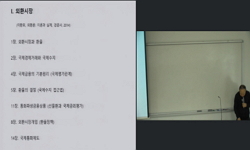본 연구는 만성 발목 불안정성을 가진 환자에게 키네지오 테이핑을 적용하여 시간 경과에 따른 정적 균형, 동적 균형, 족저압 분포의 변화를 비교 측정하고 테이프를 제거한 후에도 균형 변...
http://chineseinput.net/에서 pinyin(병음)방식으로 중국어를 변환할 수 있습니다.
변환된 중국어를 복사하여 사용하시면 됩니다.
- 中文 을 입력하시려면 zhongwen을 입력하시고 space를누르시면됩니다.
- 北京 을 입력하시려면 beijing을 입력하시고 space를 누르시면 됩니다.
만성 발목 불안정성을 가진 환자에게 키네지오 테이핑을 적용 후 시간 경과에 따른 신체 균형의 변화 = Change of the body balance according to the time over after applying th kinesio taping to a patient with chronic ankle instability
한글로보기부가정보
국문 초록 (Abstract)
본 연구는 만성 발목 불안정성을 가진 환자에게 키네지오 테이핑을 적용하여 시간 경과에 따른 정적 균형, 동적 균형, 족저압 분포의 변화를 비교 측정하고 테이프를 제거한 후에도 균형 변화를 유지하는지 비교 측정하였다. 연구 대상자는 만성 발목 불안정성 환자 38명을 대상으로 테이핑군 20명, 대조군 18명이 실험에 참여하였다. 측정은 실험에 동의한 순서대로 시간 경과에 따라 2일에 걸쳐 진행 하였으며 테이핑 부착 전 측정과 테이핑 부착 후 30분, 24시간, 48시간, 48시간 후 테이핑 제거 순서대로 측정이 진행되었다. 정적 균형 검사는 UPST(unipedal stance test with eyes closed)를 통하여 측정하였고 동적 균형 검사는 Y-test를 통하여 측정하였다. 족저압 분포는 보행 분석기(gait analyzer)를 통하여 측정하였다. 시간 경과에 따른 정적 균형, 동적 균형, 족저압 분포의 변화를 비교하기 위하여 반복측정 분산분석(repeated measure ANOVA)을 실시하였고 각 차이의 사후검정을 위하여 Bonferroni 검정을 사용하였다. 정적 균형 검사의 테이핑군에서는 시간 경과에 따라 30분 후에 4.3초, 24시간 후에 5.1초, 48시간 후에 5.9초로 정적 균형이 테이핑 이후 시간에 따라 증가하였으나 대조군에서는 유의한 차이가 나타나지 않았으며 그룹 간 교호작용에서는 유의한 차이가 나타났다. 동적 균형 검사의 테이핑군에서는 시간 경과에 따라 30분 후에는 3.6 cm, 24시간 후에는 12.6 cm, 48시간 후에는 15.5 cm 동적 균형이 시간에 따라 증가하여 유의한 차이가 나타났고 대조군에서는 차이가 나타나지 않았다. 두 그룹 간 교호작용에서는 유의한 차이가 나타났다. 족저압 검사의 테이핑군에서 테이핑 발에서 30분 후 2.7%, 24시간 후 3.6%, 48시간 후 7%가 감소하였고 테이핑을 하지 않은 발에서 30분 후 0.8%, 24시간 후 2.4%, 48시간 후 3.3% 증가하여 양발의 족저압 비율이 비슷해져 신체 균형이 정상적으로 돌아오는 것으로 나타났다. 반면에 대조군의 족저압 분포 검사에서는 손상발과 비손상발 모두 유의한 차이가 나타나지 않았고 그룹 간 교호작용에서도 유의한 차이가 나타나지 않았다. 또한 테이핑을 제거한 이후에도 정적 균형 검사에서 6초 증가, 동적 균형 검사에서 13.7 cm 증가하였고 족저압 검사의 테이핑발은 4.7%감소, 테이핑을 하지 않은 발은 3.6%증가하여 테이핑을 제거한 이후에도 잔여효과가 유지되는 것으로 나타났다.
본 연구 결과들에 의하면 키네지오 테이핑은 만성 발목 불안정성을 가진 환자에 있어서 정적, 동적인 균형의 향상과 양발 족저압의 균형을 가져올 수 있는 것을 증명하였으며, 테이핑을 제거한 후에도 자세의 안정성이 유지되고 있는 것을 알 수 있었다. 따라서 본 연구의 결과는 만성 발목 불안정성을 가진 환자를 치료할 때에 도움을 줄 수 있는 최적의 테이핑 적용 시간과 방법을 제공하게 될 것이다.
다국어 초록 (Multilingual Abstract)
The effects of Kinesio taping on changes in static balance, dynamic balance, and plantar pressure distributions were measured over time and compared in patients with chronic ankle instability. Measurements were also conducted after tape removal to det...
The effects of Kinesio taping on changes in static balance, dynamic balance, and plantar pressure distributions were measured over time and compared in patients with chronic ankle instability. Measurements were also conducted after tape removal to determine the maintenance of the observed changes. The study subjects, consisting of 38 patients with chronic ankle instability who consented to the experiment, were divided into a taping group (20 patients) and a control group (18 patients). The measurements were conducted over two days, at 30 min, 24 h, and 48 h after taping and again after removal of the tape. Static balance was measured with unipedal stance tests with eyes closed (UPSTs) and dynamic balance was measured with Y-tests. Plantar pressure distributions were measured with a gait analyzer. Repeated measure ANOVA was conducted to compare the changes in static balance, dynamic balance, and plantar pressure distributions over time and Bonferroni tests were used for ex post facto tests of individual differences. The static balance tests for the taping group revealed increases over time after taping, from 4.3 s at 30 min to 5.1 s at 24 h and 5.9 s at 48 h after taping, but no significant changes occurred in the control group; the interaction differences were statistically significant. The dynamic balance tests in the taping group also revealed statistically significant increases over time after taping, from 3.6 cm at 30 min to 12.6 cm at 24 h and 15.5 cm at 48 h after taping, but the control group showed no significant differences over time; the interaction differences were statistically significant. The plantar pressure tests for the taping group revealed decreases in plantar pressure of 2.7% at 30 min, 3.6% at 24 h, and 7% at 48 h after taping on the taped foot, as well as increases on the other untaped foot of 0.8% at 30 min, 2.4% at 24 h, and 3.3% at 48 h; therefore, the ratios of the plantar pressure of both feet became similar and normal body balance was recovered. By contrast, the plantar pressure distribution tests of the control group revealed no significant changes in the taped foot or the untaped foot and the interaction differences were not significant. In addition, after removing the tapes, the taped foot showed an increase of 6 s in the static balance test, an increase of 13.7 cm in the dynamic balance test, a decrease in plantar pressure of 4.7% on the taped foot, and an increase in plantar pressure of 3.6% on the untaped foot, indicating the maintenance of residual effects after tape removal.
These results confirmed that Kinesio taping can improve static and dynamic balance and bring about a balance in plantar pressure between both feet in patients with chronic ankle instability. The improved postural stability can also be maintained after removing the tapes. These findings also indicate optimum taping application times and methods for treatment of patients with chronic ankle instability.
목차 (Table of Contents)
- 목 차
- Ⅰ. 서론 1
- 1. 연구배경 및 필요성 1
- 2. 연구 목적 3
- 목 차
- Ⅰ. 서론 1
- 1. 연구배경 및 필요성 1
- 2. 연구 목적 3
- 3. 연구 가설 4
- Ⅱ. 이론적 배경 5
- 1. 신체 균형 5
- 2. 키네지오 테이프의 기전 6
- 1) 키네지오 테이프 6
- 2) 피부의 휴지 모터 반사 7
- 3) 혈액 및 림프 순환 증가 8
- 4) 근육의 보조 8
- Ⅲ. 연구 방법 9
- 1. 연구 대상 9
- 2. 연구 절차 10
- 3. 실험 방법 12
- 4. 평가 도구 13
- 1) 정적 균형 검사 13
- 2) 동적 균형 검사 14
- 2) 족저압 검사 15
- 5. 자료 처리 및 분석 16
- Ⅳ. 결과 17
- 1. 연구 대상자의 일반적 특성 17
- 2. 시간 변화에 따른 정적 균형의 차이 분석 18
- 3. 시간 변화에 따른 동적 균형의 차이 분석 21
- 4. 시간 변화에 따른 테이핑군의 족저압 차이 분석 24
- 5. 시간 변화에 따른 대조군의 족저압 차이 분석 27
- Ⅴ. 고찰 30
- Ⅵ. 결론 35
- 참고문헌 36
- 영문초록 43












